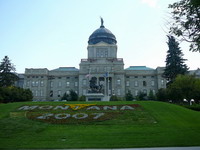Login form
Montana

Montana’s name comes from the Spanish word montaña, meaning “mountain.” Early explorers called it the Land of the Shining Mountains because its snowcapped peaks sparkled in the sunlight.
In spite of Montana’s name, mountains cover only the western third of the state. These mountains are part of the Rocky Mountains. Rolling hills, high plains, and valleys make up the central and eastern two-thirds of Montana.
THE TREASURE STATE
Montana is in the northwestern part of the United States. When Montana became a state in 1889, it was nicknamed the Treasure State because of its mineral wealth.
|
Facts About Montana |
|
|
|
|
|
Capital |
Helena |
|
Population |
918,000 people |
|
Rank among states in population |
44th |
|
Major cities |
Billings, Missoula, Great Falls |
|
Area |
147,000 square miles |
|
Rank among states in area |
4th |
|
Statehood |
November 8, 1889, the 41st state |
|
State nickname |
The Treasure State |
|
Name for residents |
Montanans |
|
State bird |
Western Meadowlark |
|
State flower |
Bitterroot |
|
State tree |
Ponderosa Pine |
|
Abbreviation |
MT |
The state has deposits of gold, silver, copper, and other valuable minerals. Today, petroleum, coal, and natural gas are more important to Montana than gold, silver, and copper.
The discovery of gold in the 1850s brought the first white settlers to Montana. They came to strike it rich.
Gold brought outlaws to Montana, too. Henry Plummer, the sheriff of Virginia City, formed a gang that stole gold. In 1863, the town organized a group to catch Plummer. Plummer never had a trial. By 1864, the group had hanged Plummer and 23 members of his gang.
Montana was made a territory in 1864, with Virginia City as its capital. On November 8, 1889, Montana became the 41st state of the Union. Helena became the capital. Helena got its start from a nearby gold mine. The city was first named Last Chance Gulch.
Montana has many ghost towns from its mining days. These towns were once booming settlements, but people left them after the mines shut down. Buildings from the 1800s still stand, and you can learn what life was like back then. Virginia City is a ghost town.
CUSTER’S LAST STAND
The gold miners and the pioneers who followed the miners to Montana moved on to Native American lands. They hunted the Indians’ animals, and they forced the Indians to move. Treaties with Native Americans were often broken. Sometimes, Native Americans attacked settlements or stole the settlers’ cattle or horses. The United States Army sent Lieutenant Colonel George Custer to protect miners, travelers, and settlers.
On June 25, 1876, Custer led his troops toward the Little Bighorn River in southeastern Montana. His scouts had discovered Sioux and Cheyenne camps, and Custer decided to attack. He did not realize that the Sioux and Cheyenne warriors greatly outnumbered his own troops. By the end of the day, Custer and 264 of his men had died. The battle became known as Custer’s Last Stand.
THE COPPER KINGS
The city of Butte, Montana, developed as a center of silver and copper mining. By 1900, nearly half the world’s copper ore came from the region around Butte. A hill outside the city became known as the “richest hill on Earth” because of its copper deposits.
In the late 1800s, two men became rivals for control of Montana’s mining interests. These men—William Clark and Marcus Daly—became known as the Copper Kings. They competed for power over the state’s economy and politics. They bought up newspapers.
When Montana became a state, Daly wanted Anaconda, a town he founded near Butte, to become the capital. Clark supported Helena and won. Did you know that the State Capitol in Helena has a copper dome?
GRAZING AND FARMING COUNTRY
Montana’s miners wanted to eat beef. Some settlers decided they could make more money raising cattle than looking for gold. Montana prairie grass was good for fattening cattle. In time, cattlemen began driving herds from Texas to Montana to graze on the prairie.
The railroads arrived in the 1880s. Ranchers could then ship their cattle to markets in the Midwest or the East by railroad. Billings grew as a railroad town and a place for shipping cattle. Today, it is Montana’s largest city.
Montana’s climate was not kind to cattle. In 1886, severe cold killed many of the cattle. Cattle drives from Texas ended, but cattle ranching continued. Raising sheep grew in importance. Sheep could survive drought (long, rainless periods) and severe winters better than cattle. Cattle and sheep ranching remain important in Montana.
In the early 1900s, the railroads brought European immigrants who came to farm. Drought and falling prices for farm products ended the dreams of many Montana farmers in the late 1910s. Today, Montana is a leading wheat-producing state. Irrigation has helped Montana farmers handle drought.
BIG SKY COUNTRY
Montana license plates advertise the state as Big Sky Country. The nickname reflects the feeling of freedom associated with Montana’s wide, open spaces under a big, sheltering sky. The state borrowed the name from a book titled The Big Sky about early fur traders in Montana.
The fur traders heard about Montana’s abundant beaver from the Lewis and Clark Expedition. The expedition followed the Missouri River westward across Montana in 1805. For the next 40 years, fur traders and trappers roamed the area.
The beautiful scenery of Big Sky Country brings many tourists to the state. A small part of Yellowstone National Park is located in southwestern Montana. Glacier National Park is in northwestern Montana, along the border with Canada. You can see glaciers along the Going-to-the-Sun Highway, which runs through Glacier National Park. You can also hike the park’s trails and see bears and other wildlife.
Source: Microsoft ® Encarta

